StreamLine Mic
Eric Branda, AuD, PhD
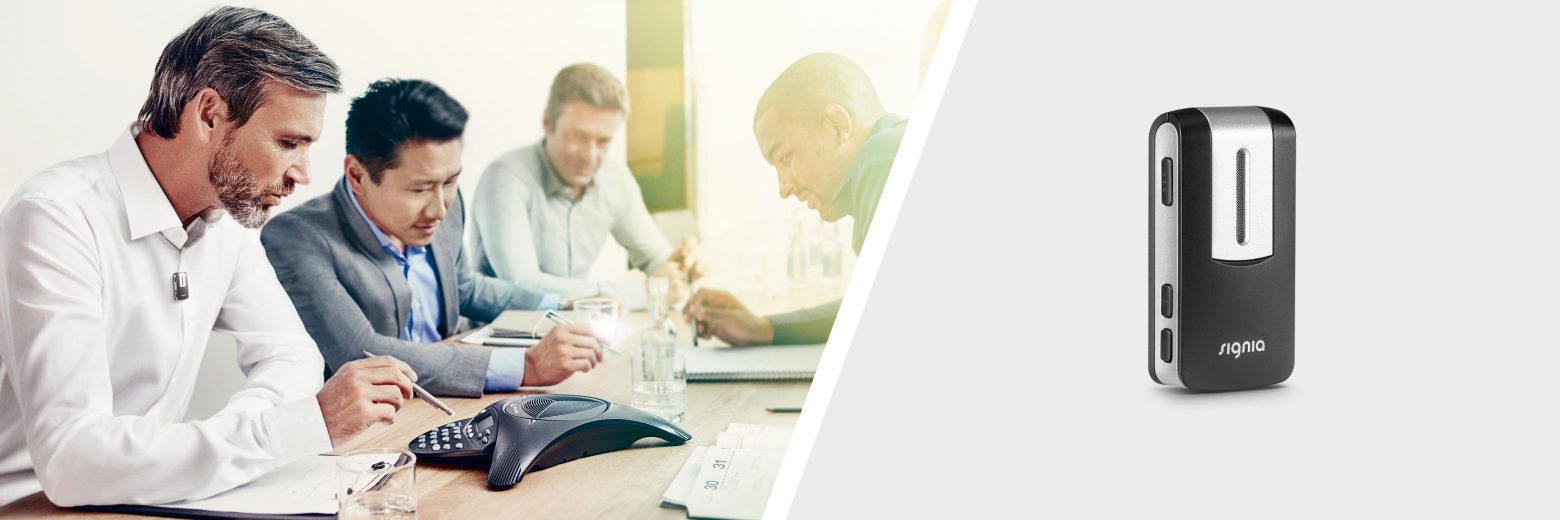
A primary goal for any hearing aid fitting is to improve speech intelligibility. It is well known that one of the most difficult listening situations for any hearing aid wearer is understanding speech in background noise1,2.
The primary reason for poor speech understanding in noise is the necessary signal-to-noise ratio (SNR) for intelligibility. Background noise can cover or mask the speech signal. This often will have a considerable impact on the softer speech sounds in the higher frequencies that are critical for intelligibility, which are also often the most affected by hearing loss.
A popular approach to improving speech understanding in background noise is use of directional technology. This is standard on the majority of RICs and BTEs and is available on larger custom devices as well. And for smaller devices, Signia offers binaural OneMic directionality.
As popular and effective as directional microphone technology is, there are some limitations to the benefit it can provide. And some of those limitations are more obvious than others.
One solution to help overcome most of these listening-in-noise challenges, and the limitations of directional technology, is the use of a remote microphone with Bluetooth capabilities. The remote microphone aspect of such a device provides many advantages to help the hearing aid wearer in difficult listening environments due to its close proximity to the speaker’s mouth. The Bluetooth capabilities also provide the option to pair with virtually any Bluetooth-enabled device in order to stream signals such as a phone call directly to the hearing aids. This combined functionality added to the hearing aid’s processing enables the wearer to hear better in a larger number of soundscapes than with just hearing aids alone.
If we consider some of the earlier mentioned challenges to providing an improved SNR to the hearing aid user, we quickly see some key advantages for remote microphones:
An additional advantage for phone conversation is that the remote microphone can pick up the hearing aid wearer’s voice for transmission to the communication partner. The benefits of the remote microphone’s directionality and close proximity to the hearing aid wearer’s mouth maintains the same acoustic advantages for the conversation partner that were discussed for overcoming noise surrounding the wearer. This improvement in the SNR helps facilitate hands-free communication between the two parties.
The Bluetooth streaming capability also provides the hearing aid wearer with music as well as other audio signals streamed directly to the hearing aids. Again, this helps overcome competing environmental signals that may mask the desired audio, so music can be more enjoyable.
The Signia Streamline mic is a remote microphone that pairs with most Bluetooth devices and streams directly to Signia Bluetooth-enabled hearing aids. The Streamline Mic can provide all of the advantages listed above. To validate the SNR benefit of the remote microphone for speech recognition, measurements were obtained with different SNRs and remote microphone placement conditions. Laboratory measures were obtained at Vanderbilt University Medical Center to evaluate the improved SNR provided by the Streamline Mic.
A pair of Pure Xperience 312 receiver-in-the-canal hearing aids were fitted to the KEMAR using occluding, non-custom eartips. The hearing aids were programmed to a mild-to-moderate hearing loss and paired with a Streamline Mic.
Two speech in noise conditions were simulated and measured. SNR levels were based on the average data reported by Pearsons et al6. Condition 1 was based on the SNR of an outdoor speech situation with speech presented at 66 dB SPL and competing noise presented at 61 dB SPL (+5 dB SNR). Condition 2 was based on the SNR in train with speech presented at 73 dB SPL and the competing noise at 74 dB SPL (-1 dB SNR).
Target speech was presented from a speaker placed 1.5 meters from the KEMAR. The Streamline Mic was placed directly in front of the target speaker at 0 degrees. The Streamline Mic was measured in two positions. The first position was directly below the speaker and angled up toward the speaker to simulate being worn on a cord around the neck (Referred to as “Below Chin”). The second position was with the Streamline Mic position flat in front of the speaker to simulate the user holding the it directly in front of the mouth (Referred to as “At Mouth”).
Speakers presenting competing speech babble were placed 3.5 meters from the KEMAR. Each condition included 2 noise loudspeaker configurations, either with the noise signals directly behind the KEMAR (speakers at 135 and 215 degrees; referred to as the two speaker condition, Figure 1), or the noise signals surrounding the KEMAR (speakers positioned at 45, 135, 225, and 315 degrees; referred to as the four speaker condition, Figure 2). Therefore, recordings of speech and noise were made in 8 conditions (2 microphone locations x 2 SNR conditions x 2 noise configurations).
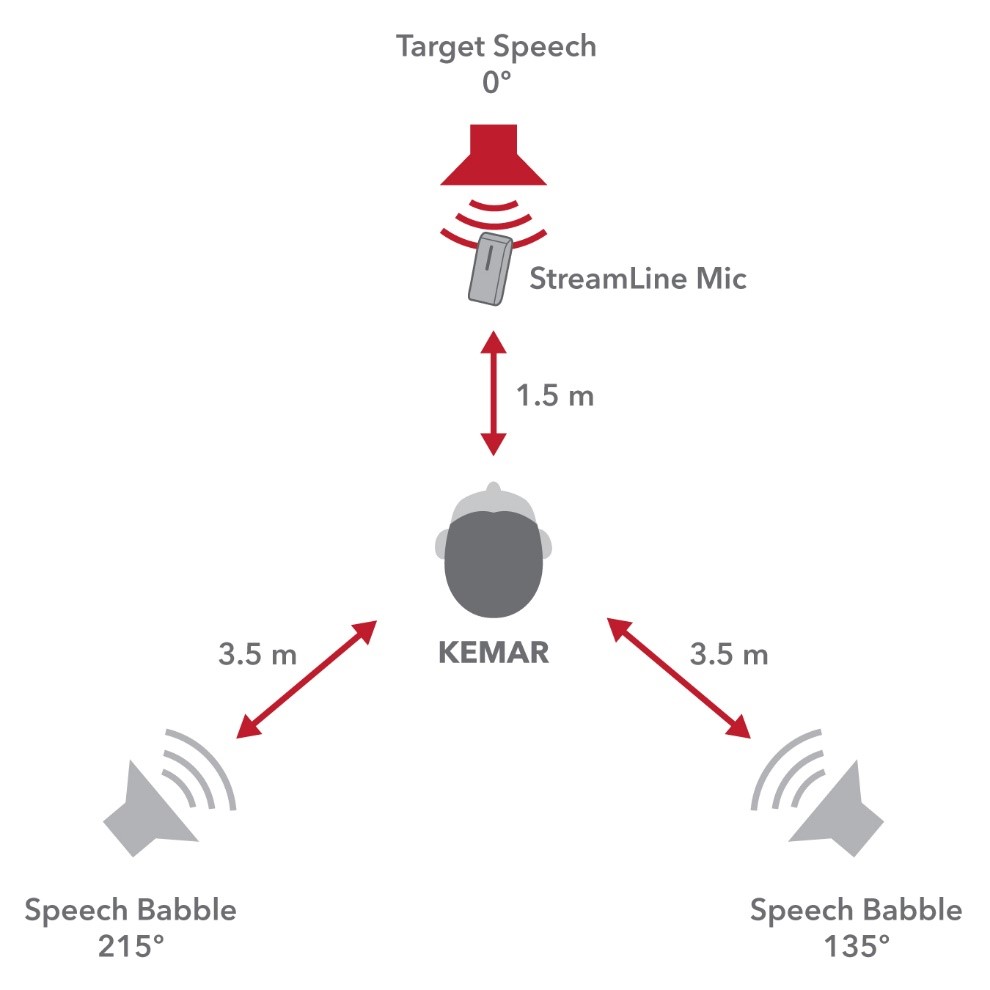
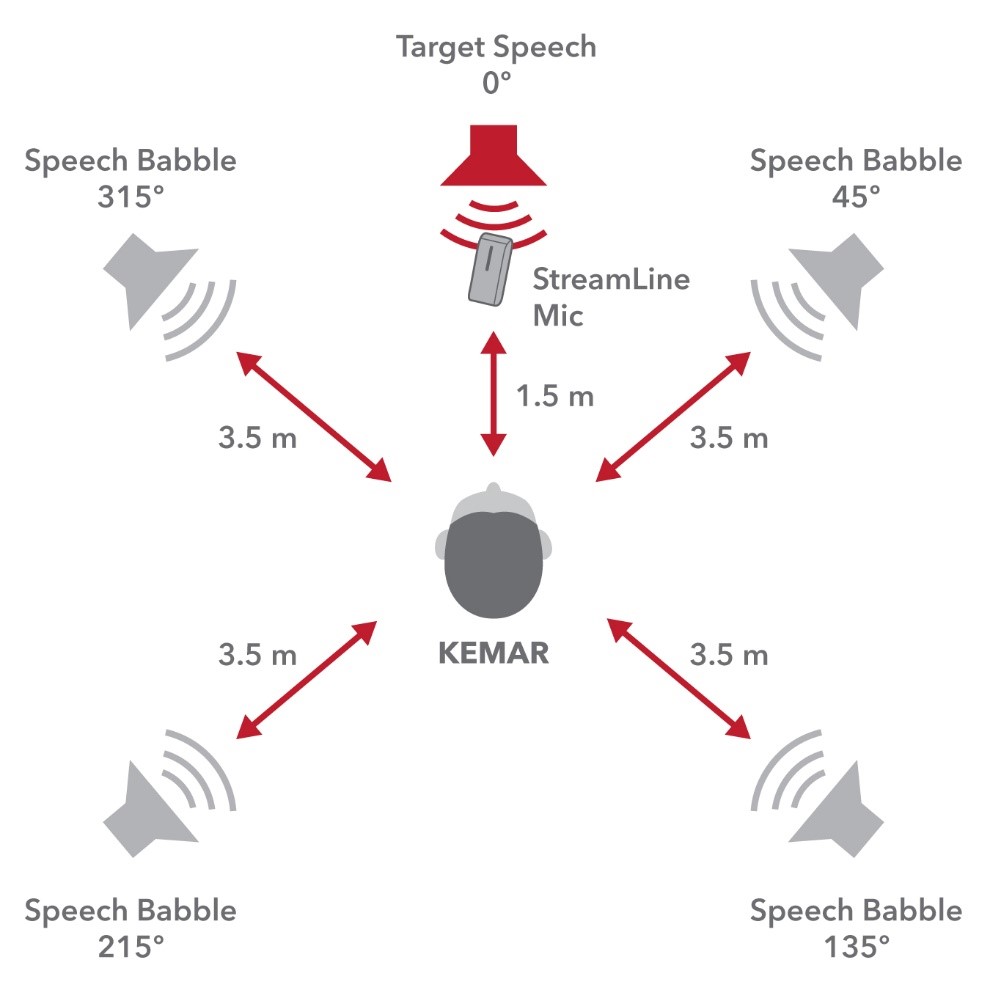
In each of the 8 conditions, sentences from the Connected Speech Test7 were presented from the loudspeaker located directly in from of the KEMAR. The background noise, a multi-talker babble with 4 talkers, was presented from the 2 or 4 loudspeaker condition. One passage pair of 10 sentences was recorded in each condition. Recordings were made through the KEMAR with IEC 7-11 microphones, routed to a pre-amplifier, and into a Dell laptop using Adobe Audition (v1.5). The levels of the speech in noise were measured in Audition, in addition to the noise levels (taken during the silence between the sentences). The first 2 seconds of noise were ignored for the purpose of analysis.
Total RMS values for each measure were recorded from Amplitude Statistics in Adobe Audition. The remote microphone advantage was calculated first by determining the signal-to-noise-to-noise ratio (SNNR) by measuring the difference between a noise only presentation to a speech-with-noise presentation. The difference between the omni-directional SNNR and remote microphone SNNR is the remote mic advantage.
Figure 3 shows the recordings in the time domain for omni-directional and Streamline Mic (At Mouth) recordings of the +5 dB SNR, 2-speaker condition, respectively. The reduction in competing background noise is visually apparent when comparing the two figures. The Streamline Mic advantage for each condition and microphone position is presented in Figure 4.
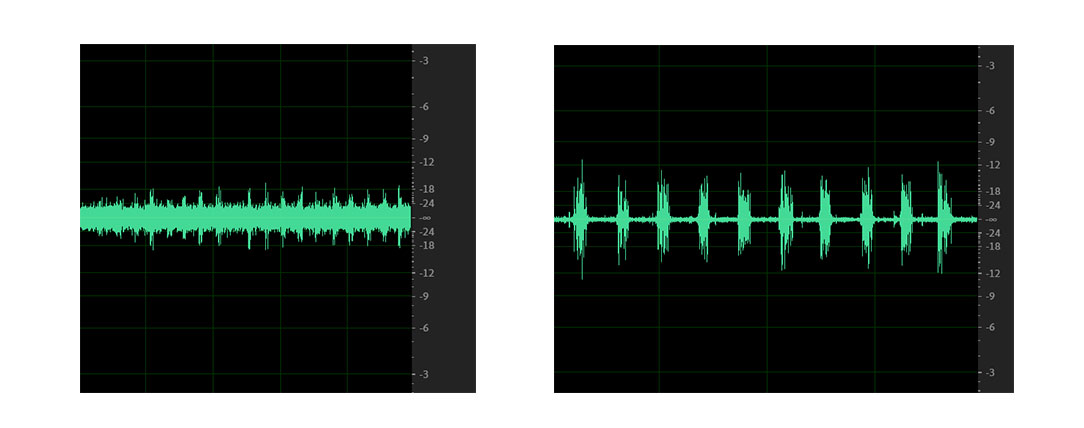
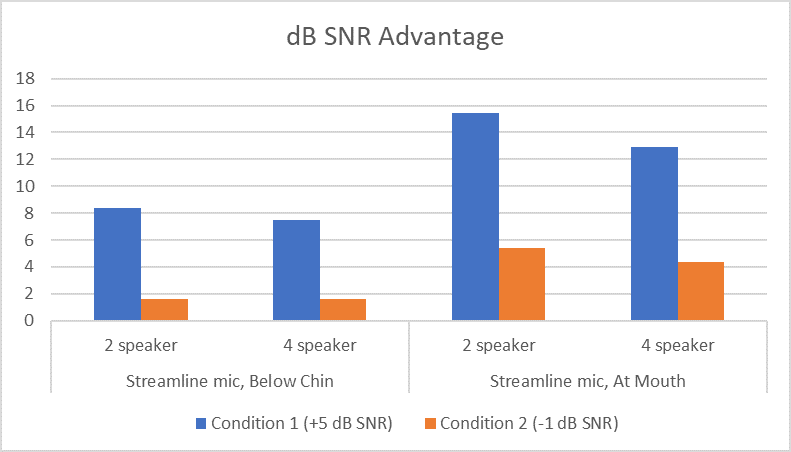
In all situations, the Streamline Mic provided an improved SNR. The differences between the 2 speaker and 4 speaker conditions were not large, suggesting benefit for difference listening conditions. The lowest improvement was ~2 dB in the very difficult –1 dB SNR situation for the Below Chin placement. The maximum advantage was observed at over 15 dB for the +5 dB SNR speech condition for the At Mouth placement.
These data clearly demonstrate the potential for Streamline Mic to improve the SNR in a variety of listening situations. Even in circumstances of very difficult listening, the Streamline Mic can positively affect the SNR for the hearing aid wearer. Based on the degree of benefit afforded by the Streamline Mic, we would expect hearing aid users to have 15 to 100% improvements in speech intelligibility for a variety of listening conditions, if we assume an approximate 10% improvement for every 1 dB change in the SNR. Although the actual benefit experienced by a hearing aid wearer will vary based on their auditory abilities and the acoustic environment, we certainly would expect wearers to benefit in nearly all listening situations. Even in cases where speech recognition is at or near 100%, the SNR advantage provided by the remote mic will provide more relaxed listening and reduce listening effort.
Hearing aid wearers often put high demands on their amplification technology. Situations like speech understanding in background noise are often the most challenging and require SNR improvement. These needs carry over to use of smart phone and other streaming opportunities. Providing a remote microphone accessory such as the Streamline Mic can support these SNR improvement needs while also opening up more streaming opportunities with phones and other devices.
The author would like to thank Erin Picou for insights and assistance in data collection and analysis. Additional thanks to Anna Javins for assistance with the data analysis.

Dr. Eric Branda is an Audiologist and Director of Research Audiology for Sivantos in the USA. For over 20 years, Eric has provided audiological, technical and product training support around the globe. He specializes in bringing new product innovations to market, helping Sivantos fulfill its goal of creating advanced hearing solutions for all types and degrees of hearing loss. Dr. Branda received his PhD from Salus University, his AuD from the Arizona School of Health Sciences and his Master’s degree in Audiology from the University of Akron.